(As with all of my photos in this blog, the photos on this page are licensed "CC BY," which means you can copy them freely as long as you acknowledge Dennis DeBruler as the photographer. As a courtesy, If you use some of the photos, I ask that you send me a copy/link/reference of where they were used to bruler <capital 2> xnet <period> <three letter "word" that means commercial>.)
This posting has probably way more detail than you are interested in. I have written a summary of assembling the mobile crane and removing the tower crane..
Before I show the April 8 photos, I found some photos and a video from 10-18-2017 that shows the tower crane's main job at this construction site --- lifting and placing prefabbed wood panels.
 |
| 20171015-19 7041 |
At 4:52:48, it is still dark. I have cranked the ISO up to 6400. Fortunately, there is no traffic at this hour on a Sunday morning. I'm looking East across the intersection of Main and Maple along Maple. The faint white on the left is the building being constructed. The truck on the right is the barricade provider. The driver will get out at 5:00 and pull the barricades that he has already unloaded across the road.
I walked north of the intersection to the gap between the new building and the existing building to catch a shot of the tower crane that is going to be taken down. Main Street has sodium street lights, and they do provide better light. I use an 18-55mm zoom because I can digitally zoom for my web content needs. Although with ISO 6400, the graininess of the photo becomes an issue when I digitally zoom.
 |
| Digitally Zoomed |
5:00:15 Barricades are being moved.
5:05:13 I almost left in disappointment. Fortunately, I stuck around a little bit because the trucks started to roll in. By the way, it was cold for an April day, below 30. I had my winter coat and hat on and was taking pictures with gloves.
5:06:24 The Grove GMK5275 arrives. Note the boom dolly. This crane has a telescopic boom. The lattice work you see is a "jib" carried on the side of the boom. They used a jib on the Downers Grove High School job. But they didn't need it for this job, which makes crane assembly and disassembly go faster.
Followed by a "tools" truck.
The crane is in the middle lane of Maple Avenue, and the two trucks are in the outer lanes past the crane. The tower crane is provided by Custom Service Crane.
I'm walking East behind the houses on the south side of Maple because I don't feel comfortable walking down the sidewalk on a closed street with so much construction activity until I get a better feel for what is happening. I caught a view between a couple of the houses with the boom of the tower crane over the new building and road. I think it is still parked in "windmill mode."
This is a shot looking West down Maple from the east road barricades. The trucks don't look loaded, but they are. They carry the counterweights that will be placed on the rear of the crane housing. The counterweights are just several inches high but 10 tons each. One is placed over the truck's axles, and the second one is placed over the trailer's axles. We will soon see much better views of the counterweights.
 |
| Digitally zoomed into the two counterweight loads of the left truck. |
I'm making sure I get a good photo of the model number of the Grove. But it turns out I was able to read it off the arrival photo.
You don't see this view of a "naked" (no counterweights) crane too often. As we will see, there will be several counterweights filling the gap between the crane's housing and the truck's cab.
A photo of the boom dolly. I took and deleted this photo more than once trying to get rid of the blur. I guess I can no longer handle 1/5 sec exposures. I'll be glad when the sun comes up.
The block and hook are so bright because there are lights in the crane's boom designed to illuminate the hook.
So while I walked around the backs of the houses to get to the east side of the action, they had lifted the boom off the dolly and extended the outriggers part way using the built-in pads.
05:23:50 Here comes the third truck that they were waiting for...
...because what looks like four weights over the rear axles are the heavy duty support pads for the outriggers. The current outrigger configuration can hold the crane only without the counterweights and with a short boom.
By hooking to the bottom pad, they can lift all of the pads at once off a truck trailer that is beyond the trailer we can see.
A couple of guys have turned the pad stack so that the bottom pad will be...
...just past the current small pad.
They removed the straps from the bottom, fourth, pad and hooked them to the third pad.
5:21:40 They are swinging the pad stack to the other side so that they can drop a pad at each corner of the crane.
05:26:25 They have swung back to my side with the remaining pad for the remaining corner.
05:31:14 The guy standing between the two pair of wheels has a cover open and is operating the outrigger controls. The blur to the left of the pad shows that I can still hold the camera study for slow shutter speeds (1/4 in this case). The worker in a hurry probably needs to remove a pin from the outrigger before they can extend it. While he is moving to position, they will raise the pad.
They have already raised the pad and are extending the outrigger so that the little pad will set in the middle of the big pad.
05:31:34 The little pad has been lowered to raise the crane off the tires and the crew member is putting a pin back into the outrigger.
5:32:02 And now they are raising, extending, and lowering the other outrigger pad.
5:38:29 After doing the two pads on the other side, they partially extended the boom and started lifting the counterweights off the truck trailers.
5:40:54 ...this crew member is guiding holes in the counterweight to cover. The cone shape allows the worker to get the weight in the vicinity, then the cones will precisely position the weight as it is lowered. (Shutter speed 1/3 with ISO 6400. I still need to sun to come up!)
5:42:58 Here comes another truck to help haul parts from the crane tower.
5:43:13 They lift the counterweight that was over the truck's axles.
5:43:51 And swing it around...
5:44:31 ...to start the stack of counterweights on the base unit.
This is blurry, but you can still see that the counterweights have two holes to accommodate the "pillars" in the base unit.
5:57:06 The meeting is over. And the shutter speed is up to 1/15.
One advantage of a telescoping boom crane is that the boom can be lower than the tower boom when doing counterweight work and then later can be much higher than the tower boom when they lift it off the tower.
5:59:55 I promised we would see more of the counterweights that I zoomed into above. Here they are hooking up to the weight over the rear axles of the second trailer.
6:00:29 The weights are built with lugs on each corner so that they can quickly wrap four straps around the lugs. While they were doing that, I walked down the sidewalk to try to get a better angle to see how close the top of the crane boom was to the tower boom. But I would have to walk a lot further east than I was willing to walk to see the gap.
6:01:27 The weight is going up. We can see the boom is about 1.5 extension segments past the base segment.
6:01:35 The weight is going up and over to the stack.
6:02:37 As we have seen, the two holes in the weight have to be lined up with the pillars. Another reason you want a shorter boom for the counterweights is that the radius is just a few feet when installing the weights. That means the boom is about straight up.
6:03:04 The man in the foreground has unchained the weight that is over the truck's axles and is waiting for the rigging to come back to him. The man in the background is watching the weight slide down the pillars and will unhook the four straps as soon as they become slack. I've watched cranes with smaller crews, and the operator himself comes out of the cab to unhook the four straps.
6:04:35 The rigging has arrived at the next weight. The shutter speed is up to 1/100.
6:05:12 The weight is strapped and off the truck.
This taller counterweight was not used. I never did figure out where/how it would attach to the crane.
6:05:50 Swinging and booming up the third weight to the crane and....
6:06:30 ...lining up the two holes.
I'm still trying to figure out how that extra weight would have been mounted.
6:08:01 Picking up another regular (thin) weight off the rear of that trailer.
6:08:31 And we have liftoff.
6:08:45 Steady as she goes.
6:09:07 I must have good peripheral vision upwards because I noticed...
...the tower boom started turning.
6:09:15 Yep, that is not just the wind blowing it.
6:09:17 In the meantime, the fourth weight is almost to the stack.
6:09:44 Down it goes.
6:10:05 Time to "thread the needle."
As the crane swung around to the truck on the other side, it occurred to me that I'll probably never get a closeup view of a crane like this again, so I took a picture of the crane itself. In particular, another set of hydraulic hoses and probably a hydraulic fluid tank.
I cranked up the brightness and contrast, but it is still a disappointing closeup.
6:11:37 They are pulling the little hook out of its travel container.
And setting it down so that they can attach the cable to it later.
In the meantime, a guy is unloading a bunch of boards off a trailer.
6:13:56 Note the "sliver" rams are sticking out below the yellow hydraulic cylinder and on down into the blue weight stack.
 |
| Closeup |
6:14:34 I'm so excited that I noticed that because that means I finally caught them raising the counterweight stack off of the truck bed and attaching it to the crane's "rear end.".
6:14:39 And to have such a closeup view of it is even more rare. Those rams attach to the top of the pillars on the base counterweight as I mentioned above.
6:14:49 Now that I have some sunlight (still ISO 6400 though), you can clearly see the two cones on the crane bed that make sure the two pillars are right under their two lifting rams.
6:14:45 The sun is coming up.
6:18:51 Another empty truck is arriving.
6:18:54 And will back in as soon as the barricades are temporarily moved. It is a good thing that traffic is still light.
6:19:28 I missed when he pulled the boom back in.
6:19:44 They are setting the big hook down on the trailer and...
6:20:10 ...lowering the boom so the tip is just above it. I'll soon learn that they are replacing the big hook with the little hook.
6:20:27 First he unhooks the-hook-is-too-high sensor. I'm sure there is a more technical term for that sensor, but I don't know it. It hangs about four feet below the boom.
6:21:16 They had already unhooked the end of the hoist cable from the crane and pulled it back through the block. (They did that part so fast, I didn't even notice it.) The guy with the pliers is refastening a bracket that helps hold the cable in the sheave. (I've learned that crane workers use the word sheave for what I would have called a pulley.)
6:23:01 While the two guys on the left chain the big block to the truck, the guy on the right is connecting the end of the hoist cable to the little hook.
I switched to ISO 1600.
6:23:12 More chaining and connecting.
6:23:51 The crane operator has come out of his cab to move the hoist cable from his left sheave to the right sheaves. Here he is removing the brackets that hold the cable in the left sheave.
Think about how precisely that trailer was parked so that when the block was in the correct position on the trailer, it would also be in the correct position to be a ladder for accessing the end of the boom.
6:24:06 He has the cable out of the left sheave. We can see the two brackets that have been pulled aside to allow the cable to be lifted out.
6:24:28 Making sure the two brackets for the right sheave are out of the way.
6:24:31 And plopping the cable into the groves.
6:24:59 The bracket has been put back on the lower sheave. He is removing a "black thing" from a bracket that stores it when not needed.
6:25:14 He has it out.
6:25:30 And he is installing it with a persuader (hammer). It looks like another "black thing" remains in its storage bracket.
6:26:38 He is changing some wires around. I think they are part of the-hook-is-too-high alarm.
6:29:04 All done with the switching of the hooks. The crane operator did a walk around to visually inspect everything before getting back in the cab.
6:31:04 I noticed the rear of the tower crane is peaking out over the edge of the building. In the closeup below, we can see the counterweights are T-shaped. The size of the cap that sets on top of the orange frame varies. The stem of the T fits down between the girders of the frame. We will have a better view of a counterweight later.
 |
| Digitally Zoomed |
6:31:53 ...then another when that segment was done extending. It took 35 seconds for the extension.
6:32:54 There is a long pause after one segment is extended and before the next segment extension starts. But the second segment has now started it extension. The pause was over a minute, specifically, 61 seconds.
6:33:32 The second segment is done extending. The hook needs to be lowered after each extension, but that happens rather quickly. It took 38 seconds to extend.
6:34:39 Third extension starting. Another pause over a minute, 67 seconds.
6:35:16 Third extension done. 37 seconds
6:37:25 Fourth extension done. 39 seconds
6:38:35 Fifth extension started. Pause was 70 seconds.
6:39:11 Fifth extension done. 36 seconds
6:40:27 Sixth extension started. Pause was 76 seconds.
6:40:37 But the sixth extension was halted at the above 6:40:27 position.
6:40:44 Sixth extension resumed after 17 seconds.
6:41:22 Full boom, 223 feet. This extension took 55 seconds because it halted for 17 seconds.
I celebrated by changing my ISO from 1600 to 400. 400 is what I normally use.
6:42:09 Note the, what I presume is, a man basket behind the worker. They start by moving a tool box off...
6:42:46 ...the last truck that arrived and setting it out of the way by the building.
6:44:01 They move the man basket to one of the trucks that had counterweights on it.
An overview shot to put the full boom, the building, and the rear of the tower crane in perspective.
6:45:27 They are done unhooking the man basket and the little hook is up in the background tree line.
6:47:18 They are hooking on the rigging that will be used to take the counterweights out of the tower crane.
6:47:36 Note the bags on the end of the rigging. I learn that they hold the ropes that will be used to guide the tower boom when they lower it to the street.
6:47:39 I think I took this photo because they were hoisting up at full speed. So it took 3 seconds to go up about two stories.
6:48:34 The hook is high enough that no one has to worry about the rigging hitting the roof.
6:49:35 Since the building blocked my view of the action from Maple Street, I headed north and noticed a worker riding the carrier.
6:49:58 He is now all the way to the end. He has one of those bags with a rope on the carrier.
6:53:49 This is the view between the new building and an existing building. This is not a good view to see what is happening.
6:56:57 So I drove to the parking lot that is north of some buildings along Main Street and north of the east end of the new building. The new building is so tall that I'm looking over the existing buildings. The mobile crane is already lowering a tower crane counterweight down to one of the truck trailers.
6:57:04 My eye was keying off the boom too much, and I screwed up the vertical alignment on this shot. Nonetheless, I caught the worker riding the carrier back to the tower.
As he rode the it back, he strung out rope from the bag. He must have reached the limit of the rope because he is tying the bag to the boom here.
6:57:56 Four workers have climbed the tower. In addition to the worker on the carrier, there is an operator in the cab, and two workers helping to hook the rigging to the counterweights.
6:58:33 The two workers are connecting the rigging to the next counterweight. You can see the bottom of the counterweights hanging below the yellow steel girders at the back. Also, as we shall see, the worker that was in the carrier is climbing out of it.
6:58:42 And he walks the rest of the way back.
6:59:11 The worker on the boom must have some work to do near the tower because we will see him in that position for a while.
6:59:29 The counterweight is coming out of the frame.
6:59:36 Now we get a good view of what one of the counterweights looks like.
6:59:51 The weight is being slewed back over to the street. You can't see it very well in these views, but the crane is also booming up because the radius to the tower crane is longer than the radius to the truck trailer on which the counterweights are being loaded.
6:59:58 The weight has been lowered out of our site.
7:03:10 The worker that was on the boom is no longer there. But the tower hook carrier has moved closer to the tower. If you look on the left side of the photo, you can see the bag that he left on the boom. (It never occurred to me before that "left" has two, completely different, meanings.)
7:03:36 This is when I noticed that the carrier had been moved closer to the tower because I saw the tower hook going up.
7:04:27 The mobile crane is coming back for another counterweight. But it is also bringing the second bag of rope. Keep in mind the crane operator can't see where the weight is. He and some of the workers wear headphones and a microphone.
7:04:55 And there goes the next counterweight.
7:06:06 A couple of photos to get timestamps.
7:06:16
7:07:45 I went back to the traffic barrier at Maple Avenue to catch a view of the unloading end of the operation as I was leaving to take a break. I'd been up since 4:30, and unloading the rest of the counterweights gave me a chance to go get some breakfast because it is more of the same.
7:25:45 I'm back. Notice that there is just one counterweight left. It will remain until they get the boom off.
7:30:18 Since they are turning the crane to switch from counterweight unloading to boom removal, I'm hustling back to Maple Street and didn't take the time needed to get a square shot. I could not have timed my breakfast interval any better.
7:31:54 They are lowering the rigging to the center of gravity of the boom.
7:34:35 That's the first fastening.
7:35:09 That's the last fastening.
7:35:18 Remember that bag at the end of the rope that was left on the boom? He is unfastening it and...
7:35:18 ...lowering it to someone on the roof.
7:35:36 The worker on the boom appears to be doing a visual inspection of the rigging while the worker on the roof is carrying the bag to the edge of the roof. Note the rope attached to the bag is now looping down and over to the roof.
7:36:07 I'm bored. It is taking a while fo the worker on the roof to walk over to the edge of the building so that he can lower the bag (and rope) to a worker on the ground.
7:36:40 The worker on the boom will stay there during this sequence of shots. I decided later that he is staying there to help direct the crane operator when the rigging needs to take the boom's load.
We can see the helmet of the worker on the roof peaking over the edge of the building. And I'm bummed that I did not tilt the camera up to get more boom and less of Main Street in the foreground. The bag at the end of the rope is in front of the top story window just to the right of the top of the trash chute.
7:36:45 Now the bag has been lowered to the second story of the apartments.
7:36:51 The worker on the roof is now looking over the edge to see what is happening with the bag. It is hard to see the bag because it is at the top of the black bay window opening in the first apartment story.
7:37:06 Here we can see the bag is down at the top of the parking garage. The rigging that will hold the boom is still slack.
7:41:47 Lowering the rope and watching a guy standing on the boom was getting boring. So when I heard banging on connector pins, I switched to watching them remove the boom from the turret. While I went north, the crane probably took the slack out of the rigging so that it is now holding the weight of the boom.
7:43:08 This shot has two workers, but one is right behind the other.
7:43:22 Still banging on pins.
7:43:40 One of them is climbing down in front of the cab to work on some lower connections.
7:47:46 We have separation! (Unless you are a child of the 60s or earlier and watched the space launches that would be on all three networks, you probably haven't heard that phrase announce rocket stage separations.)
7:49:20 I was going to say I hustled back to Maple Street to catch the boom being held by just the crane. But I see it took about 1.5 minutes to get there. Note the rope going to the ground to the right of the boom in this two dimensional view.
7:49:36 I was trying to get a view with the ground man for the rope, but he is hidden behind the traffic pole. You can see his orange vest peaking out from both sides of the pole.
Then I switched to video. One thing to note is that a worker on the roof was handling a rope at the other end of the boom. At 0:40, he arrives at the edge of the roof. (Just to the right of the tall traffic light.) At 1:20, he throws the bag over the side so that a ground worker can be ready when the end of the boom goes past the edge of the roof. My camera does HD, and, in a new window where you can go full screen, you can see the bag fall against the white backdrop of the building. You can even hear the "thunk" when it hits the ground.
7:57:04 As I mentioned in the comments on the video, they held this end of the boom about six feet off the ground for a while. Here the boom is going down.
7:57:31 And down.
7:57:47 All done.
7:58:15 Note that I was on the other side of Main when the boom was being moved. I'm careful to stay well away from the action. Now that the boom is grounded, I move closer to the equipment. Here we see the rope bag and its rope.
7:58:43 The rigging is unattached from the boom and going up to get the last counterweight now that it is no longer needed to balance the boom.
Three trucks were needed to carry the counterweights for the mobile crane. And those 10-ton weights were placed over the axles. In contrast, all the counterweights for the tower crane fit on one trailer, and they can be carried in the middle of the trailer.
An overview shot of what is happening on Maple before I go back to the north side.
8:00:48 Hooking up the counterweight and...
8:01:39 ...lifting it out.
8:02:38 Since it was the last one, I went back south to catch them placing it on the trailer. So the trip from the tower to the trailer took about a minute.
8:03:14 Things are quite engouh that I feel it is safe to go get a picture of the whole boom setting on the street. Note the guide rope has already been taken off the boom. The worker at the boom is taking off the weight limit signs while...
...they seem to be restacking some of the counterweights on the trailer.
It looks like they want a little one...
...to be on top.
8:08:05 The hook is going up and back to the tower to get the cab.
8:08:52 Basically some timestamp shots.
8:13:15
8:15:50
8:19:59
8:20:19 Another separation.
8:20:25 They move slowly until they get some distance between the cab and the tower because the crane operator is listening, not watching.
8:21:14 So which trailer will the cab be put on?
8:21:27
8:21:44 The end of the trailer that has the counterweights in the middle. But this is a temporary location because the cab plus platform exceeds transport height clearances. The platform will be removed and the cab will be transported at the end of another load as seen at timestamp 10:49:58.
8:22:17
8:22:27
8:23:17 I had noticed that all of the weight limits signs had been removed from the boom.
While walking back to the north side, I took a progress shot of the one area where you can see inside the building. (The rest is wrapped with plastic because they were using propane heaters during the Winter.) Note the icicles hanging from the beam in the middle. I had gloves on, but my fingers were getting really cold before the end of the above video.
8:25:20 I thought the hook was coming down to remove the turret and frame that is on top. This view is looking East.
8:32:53 After a while I noticed that the hook was going down on the other side of the tower. So I hustled north and east down an alley I knew about to get this view looking South at the tower. But by the time I got there, the only thing you could still see was the rigging itself. I think it was lowering a power cord.
 |
| Digitally Zoomed |
8:33:14 The base of the tower is at the bottom of a three story parking garage. So the hook is still going down.
8:33:26 And down.
8:35:01 The hook is now back up and ready to hold the turret and frame as they separate it from the tower.
8:35:46 First, all four chains are properly separated.
8:38:34 There are probably lugs on the frame to attach to so that it is not only easy to make the connections, the connections are in the correct location with respect to the center of gravity.
8:40:27 It is hard to capture in a photo, but there are two workers at the top of the tower under the turret banging on connecting pins. It was easy to see the two workers in person because of their movement.
8:42:54 One of the workers is now on the left side of the tower.
8:45:59 He worked his way around to the other side of the tower so that now he is on the right side of the tower. Height is no longer a significant fall issue because he is using two straps so that at least one is always connected to the tower. Height is still a significant fatigue issue. These guys have got to be in great shape. I got sore knees from just walking and standing around while watching them work.
8:46:14 There are either a lot of connectors or one of them is stubborn because it is taking a while to get them loose.
8:47:30 The worker who was on the outside of the tower is now going down inside the tower.
8:49:12 The blue clad worker is still climbing down. The orange clad worker is still on a platform near the top of the tower.
8:50:14 The climbing worker is now below the platform in the middle of the tower segment. I presume the worker at the top is still working on removing connections from the turret.
8:53:39 I believe that is the boss that has come over to check the progress.
8:53:47 And we have another separation.
8:54:12 I grabbed this shot while I was going back to Maple Avenue.
8:54:25 Again, they move slowly until they have plenty of separation.
8:54:35 We can clearly see the worker on top now. He is staying up there to hook the rigging when the crane comes back to the tower. The worker that climbed down the tower is now in front of the top window. The lower worker will work on removing the connecting pins after the crane has the weight of the tower segment and while the top worker climbs down to join him.
Another reason for starting slow is probably to avoid introducing a pendulum effect and putting a side force on the boom.
8:55:01 I can walk south about as fast as the crane can slew the load.
8:55:16
8:55:52
8:56:17
8:56:38 Maybe I should have switched to video if I'm going to take this many pictures.
8:57:20
8:57:39
8:58:36 That little kid on the right and his Dad timed it real well. They got to see some of the more exciting action for the day.
8:59:36
9:00:02 With maybe an inch to spare.
9:00:16 Looks like they maybe even had two inches to spare. I'm reminded that this is a tower crane cab because the windshield wiper is over the lower window.
9:00:48 And the chains are slack so this lift is done, and I'm headed back to the north side.
9:02:28 As I mentioned, the worker at the top is waiting for the rigging to come over so that he can hook it to the tower segment.
9:20:50 Here it comes.
9:03:33 Contact.
9:04:21 Now that the crane has the weight of the tower, the top worker heads down while the bottom worker starts removing the connectors.
9:04:37 He is down to the safety platform.
9:09:13 A worker has appeared at the edge of the roof while the "top" worker is down to the top window level. The other tower worker is heading on down to the next segment junction.
9:09:39 The tower segment separates soon after the "top" worker has reached the lower segment.
 |
| Digitally Zoomed |
9:09:41 The top tower worker is helping to stabilize the base of the bottom segment.
9:09:45 And up it goes.
9:09:51 This explains why they put a spotter on the roof. They have to know when the segment is high enough that they can start slewing over the building to the street. These segments are 39 feet. It occurred to me that these segments require more mobile crane boom height and radius than any of the other parts.
9:10:26
9:10:38
9:11:14 They set one end down and then tilt it over on its side.
9:12:05 They tilt it on the street instead of a trailer because it is hard to tilt it at a precise location.
9:12:14 I don't know if the boards they put under the trusses protect the street or the truss.
9:12:22
9:12:31
I was killing time while they unhooked the tower segment when I came across this view of the 51-ton counterweight stack. Note another set of hydraulic controls. This is the side of the housing that is normally on the building side when I'm on Maple Avenue.
And then I remembered that I wanted to get a photo of their logo so that I could look them up when I got home: Custom Service Crane
I'm taking advantage of the crane facing north and getting another rear shot. I was thinking in terms of the counterweights so they are in the center of the frame. I wished I had framed this show with the counterweights in the lower-left corner so that I have gotten some of the jib and not the back of a traffic sign!
I was surprised to see these guys arriving. I watched them last Summer so I know that they do the precast concrete erecting work. One of the guys recognized me as the "camera guy" and talked to me. He explained that they are there to place the slabs over the holes that the tower went through because they also want to use the mobile crane. More on that later.
9:17:53 By the time I got back to the tower, the "top" worker was already at the bottom of the segment.
9:23:29 But this time one of the joints was being stubborn. I caught him in action with a pry bar. In the closeup below, you can see him pulling down on the pry bar in the top middle. On the right, we see the two slabs to fill the hole. They were left there when the other slabs were installed. And in the lower-left corner we can see the end of the hole to be filled.
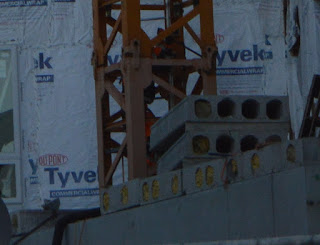 |
| Digitally Zoomed |
Now that the Creative Erectors have put on safety colors and a hard hat, they can park their trucks inside the contractors fence. (They already have the required shoes on.)
This is another demonstration about how strict this site is concerning the hard-hat rule. But in fact, I'm just killing time because the worker is still prying on that joint.
 |
| Camera Resolution |
9:26:08 Finally, we have separation.
9:26:14 This one swung rather close to the building.
9:26:21
9:26:32 The roof spotter moved over next to it to shove it away from the building.
9:27:44
9:26:52
9:27:04
9:27:16 And we are clear.
9:28:02
9:28:48 They have to fit this one between the boom and the building.
9:28:59
9:29:29
9:29:39
We had already seen that the turret section was stored just a couple of inches from the cab. Here I noticed that the other end is just a few inches from the boom dolly. At least in two dimensions. There might be plenty of room in the third dimension now that I think about it.
This is just temporary storage. Later we will see that it will be taken apart and packed better on the trailer.
9:33:58 We are back on the north side hooking the rigging to the third, and final, tower segment.
9:46:21 Another stubborn joint? I actually deleted some of the photos I took while waiting.
9:48:38 I took this one because I saw the top of the segment wiggle a little bit.
9:49:03 And then fairly soon we had lift off.
9:49:12 They had better spacing with this lift.
9:49:19
9:49:25 The crane starts slewing, and I start heading south.
9:50:15
9:50:49
9:50:59 The initial tilt does seem to be a little tricky. That is one reason why there are always three workers at the base.
9:51:09 For example, this one started tilting to the side.
9:51:53
9:52:25
9:52:42 Now it is coming down good.
9:53:04
9:53:11
9:58:38 They made another lift. But I didn't take any pictures on the north side because the load was down in the hole, and I could not see anything.
9:59:43 The load is on the ground.
10:02:58 I don't know what they are doing here.
10:10:01 Now they are rigging on the side of a tower segment so that they can precisely place it on a truck trailer.
10:12:24 Note that they had webbed straps to wrap around the truss members.
10:16:09 They are loading a trailer behind the one we see. That is why you don't see the boards between the trusses and the trailer bed.
10:24:14 Square trusses stack easily.
10:35:55 Now they start taking apart the tower boom. The worker on the left must have a headset and is directing the crane operator as to where to position the hook and thus the rigging of four chains.
10:26:27 As the boom segment is moved, the board to place under it is also moved.
10:28:17 Only the top truss members have pins. The bottom two members are always under compression so they just butt up against each other.
10:28:46 Note that they have tied a rope to the right side of the segment so that a ground worker can control its orientation as it is swung over into position.
10:29:24 This segment will ride on the other tower segment in the first trailer load.
10:47:25 Since it was pretty obvious that they were going to put the next boom segment onto the second trailer, I did a quick trip back home to get rid of the processed coffee. On the way back it struck me how far above the buildings a 223' boom reaches.
10:49:17 When I got back, I was surprised that the boom was not shorter.
10:49:58 I almost missed that the cabs original resting place was temporary. It rides back to the yard on the first trailer load. Notice that a lot of big straps have been put around the trusses. And a couple of diagonal straps have been put on each side of the cab.
10:50:12 The other component set on the counterweight trailer was also just temporary storage. The crane has been attached to the counterweight and machinery frame so that they can separate it from the taller turret section.
10:53:49 Note that the counterweights have been strapped down and two boards are placed on top of one end.
10:54:55 The frame is separated from the turret guts so that the turret can ride square on the trailer.
10:55:32 We have separation. Note the worker on the left helping to study that end of the frame.
10:59:01 A few minutes have elapsed because the first time they tried to set the frame down, the angle part would have hit the counterweight. So they had to lift the frame and shove it closer to the turret.
10:59:38 As you can see, it has to fit on the trailer just right. The designers of cranes want to get pieces that are as big as possible and still fit on a trailer in terms of dimensions and/or axle weights. Actually, these pieces are probably designed to fit in 40' intermodal containers.
In hindsight, I should have stepped to my left to be square with the gap. Because of my angle for this photo, the gap appears to be smaller than it actually is.
11:01:02 This is an "I'm bored" shot so I got another overview of what was built with the tower crane.
11:02:41 Remember that little load they set down by the building? Now it is obvious it was the power cable that we (almost) saw them lower before they started taking the tower apart.
11:02:58 During my bathroom trip when I missed that they transferred the cab to the other trailer, I also missed that they first took off the platform that was on top of the cab. If you scroll back up to timestamp 8:21:44, you get a good view of how this platform sat on top the cab.
11:05:43 I guess the Custom Service Crane crew broke for lunch because the Creative Erectors got a turn using the crane.
11:07:08 The first crane operation was to boom way down to reach over the far side of the building where a needed concrete slab had been stored.
11:07:13 I took this shot to capture how short the boom ram extension is with a full length boom.
11:08:29 They still need a few more feet of "stretch." But the boom is getting close to the roof of the building.
11:09:08 It occurred to me that a profile shot might be a better view of the fact that they need the boom lower to get the hook past the edge of the building but the boom is getting close to the roof.
11:10:51 I walk east on Maple to get a better view of the spacing between the boom and the roof.
11:12:30 In the meantime, the first of three loads leaves for their yard.
11:13:02 They are getting closer to the other side of the building.
11:14:11 I walked over to the crane house to see if I could find an external boom inclination meter. Some cranes have them, but not this one.
11:15:29 They are hooking onto the slab.
11:15:36 Fortunately, in terms of lifting a load with a long radius, this is a relatively short slab.
Below I include a couple of photos from when Creative Erectors were constructing the three story parking garage to show that most of the slabs were considerably longer.
 |
| 20170815 2533 |
11:16:10 They have done a controlled 90-degree turn close to the building.
11:16:27 I wonder if they got a few more inches of stretch from boom deflection. If the boom did deflect, I wonder how close it is to the roof. I was too focused on getting photos of the slab lift that it did not occur to me to get another shot of the boom/roof gap.
11:17:22 It is in the clear and on its way to the north side of the building.
11:18:49 So I have also headed north.
11:19:20 The slab is going down to the hole.
11:20:14 Now someone is pulling on a guide rope.
11:20:51 This slab is for a hole in one of the two lower floors and needs to go through this hole.
11:26:11 But turning it 90 degrees did not provide enough room to fit through this hole.
11:28:19 So they had put it down and shortened one of the chains so that the slab is on a diagonal.
11:30:30 But it was not enough of a diagonal to fit through the hole.
11:31:02 So they put it down again and significantly shorten one of the chains. I'm curious as to how steep a diagonal can they do before they have to worry about the lower steel rope slipping up the side of the slab.
11:31:50 Now they can carefully guide the slab down through the hole.
11:34:02 It fits this time.
11:34:32 That is all I'm going to be able to see for a while. There are two holes down below that they need to fill with four slabs. The other three slabs evidently are available near their holes as we have seen with the two slabs next to the top hole.
11:36:38 So I'm basically killing time taking overview and detail shots.
The model number is CT250-5
11:49:59 The second load is leaving.
11:58:11 They are ready to work on the top hole, which I can watch.
11:59:06 The slabs are always laid on a couple of boards so there is a space underneath the slab that allows them to thread the steel rope under the slab.
12:00:48 It need not be lifted very high.
12:01:38 Turn and...
12:02:56 ....place it into the hole.
12:05:00 Still placing.
12:06:29 He is using the steel rope to push the slab out then pull it back to bang against the slab that has already been installed. I've seen them do this last Summer. They basically use the suspended slab as a big hammer to adjust the position of the installed slab. But the need to do this is the exception.
12:09:01 The hook is going up while a worker uses a pry bar to fine tune the location of the slab they just installed. Pry bar work to fine tune the final position is needed for each slab.
12:13:58 Slab work usually goes pretty quick. But they spent quite a few minutes on this one. I overheard one guy say "a half inch."
12:14:30 They released the crane to the Custom Service Crane crew.
12:16:19 So I'm back on Maple Avenue.
12:16:33
12:18:19 This was the boring part I though I was going to miss when I took my bathroom break. But they had worked on the cab and its platform instead so that the first and second loads could already leave.
12:18:53 These boom segments and some miscellaneous stuff will be the third and final load.
12:19:19 The connector pin is most of the way out.
12:19:22 These pins came out pretty easily.
12:20:25 A simple matter of booming up and slewing a little to get it on the truck trailer.
12:21:32 Or so I had assumed. Actually, they laid it back down on the street.
12:22:14 Getting ready to pull the pin for the next segment.
12:23:18 This segment is going directly onto the trailer. I deleted five photos because they must have had some trainees. They moved from the rear of the trailer to the front and then went down and up and down to get the truss and its support boards properly aligned at the edge of the trailer.
12:25:52 Finally, the rigging goes slack with the segment in a position that they are happy with.
12:27:56 Actually, I'm glad I caught this work instead of the cab disassembly because I had been wondering how you stack triangular segments. The answer is that first you flip the second segment onto its side so...
12:29:36 ...you can connect to the bottom two chords and...
12:30:20 ...lift it upside down.
12:30:48
12:31:21
Maple Avenue is a three lane street. I had noticed that they were using most of the width of the street. It occurred to me to take a photo to explicitly record how much space they had to spare. The crane was parked in the middle of the street.
12:33:33 While the crane holds the second segment that is setting on its point, they strap it in several places to the first segment that is setting on its base.
12:34:00 They pull fresh strap out of a box and then cut it to length with scissors. That gives a whole new meaning to the phrase "scissors man."
12:35:49 It took a while to get enough straps secured before they released the crane.
12:38:20 Some workers continued to add straps for transport while others started work on the next boom segment.
Since it turned out to be a nice sunny day, at some point I cranked the ISO down to 100.
12:39:27 The work goes fast when you don't have to disconnect a segment.
12:40:27 As one would expect, it is placed next to the upside down segment.
12:41:08
12:41:49 Then they go back and pick up the short segment that is at the tip of the boom.
12:42:11
12:42:24 Attaching a guide rope.
12:43:01 There is plenty of vertical clearance for it to fit on top of the other segments. Two boards will be placed on the lower segments to hold this upper segment.
12:43:27 When the crane operator can see the worker, I noticed that they use hand signals instead of headsets.
12:43:35
12:44:29 Slack rigging means this lift is done.
12:46:02 They evidently provided their own dumpable trash bin because that is what they picked up next.
12:46:07
(new window)
12:51:16 I had to wait until they lifted this load to see what they were doing. I recognize these two weights from when I took pictures of the installation of the tower crane. These are test weights for the tip capacity. I presume it should be able to lift 2404 pounds without sounding the overload alarm. When about 10% more weight, 245 pounds, is added; the overload alarm should make noise.
12:51:17 I took another photo to make sure the numbers were readable.
12:52:03 Over a ton of weight will help keep the trash bin on the trailer! And the weights can be transported without using any extra trailer real estate.
12:52:14
12:52:14 Putting the lift bar back into its upright, locked position. (Fortunately, it has been a while since I have had to fly on an airplane. I had to think hard about the instructions concerning the tray and seat back when landing. (Actually, I don't mind flying; it is the airports that I don't like. (And yes, my English teacher did teach me that you should not nest parenthetical phrases. But I programmed for over 40 years, and I think nested expressions are too useful to avoid. Plus I'm going a little stir crazy describing almost 400 photos.)))
12:54:59 Getting shots of...
12:55:14 ...both sides of the third, and final, tower crane load now that room on the street has cleared up.
12:57:09 Since the crane was facing north, I went back to the north side to see what was happening. Since the Custom Service Crane crew is now done with the mobile crane, the Creative Erectors can use the crane again.
Earlier I had heard someone say give us a half hour. And later I overheard "get the grinder."
12:57:58
13:02:31 Even though I'm describing these photos fairly soon after I took them, I can't remember why I went back to Maple for this shot. My left knee had been hurting me for about the last hour, so I would not have casually walked back there.
13:03:34 They have lifted the final slab and are prying it into the hole.
13:03:53 They are prying first one side and then the other.
13:04:06 And prying.
13:04:13 Bingo, its in.
13:06:58 And up goes the hook, four chains, and two steel ropes.
13:07:10 Until it is clear of the roof.
13:07:31 A parting shot of the mobile crane because I was not going to stick around for the disassembly. I had intended on skipping that long before I was sore and hungry because I have seen other cranes disassembled, and it is basically the assembly done in reverse.
13:07:40 I was able to catch the time when the final load for the tower crane parts left.




















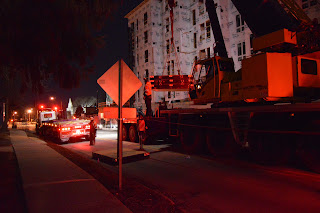

































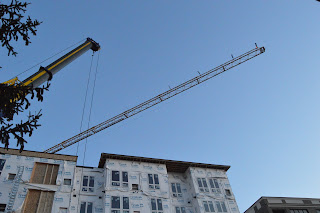





































































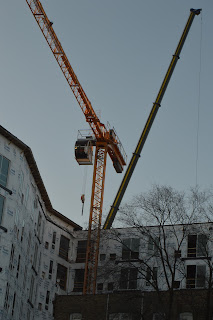






















































































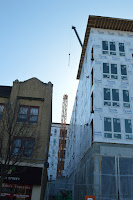







































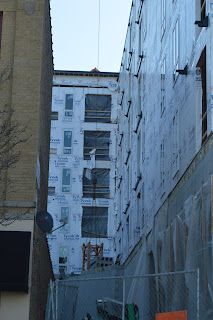



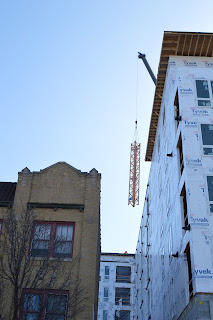


































































































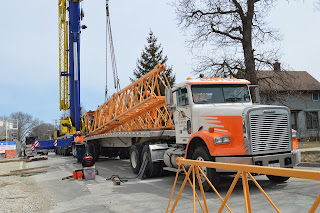












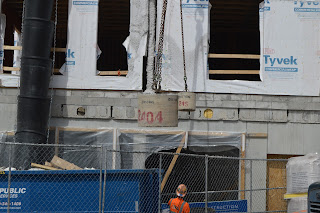
















The practice of geotechnical engineering is a vital part of many construction projects. It is important to keep in mind that earthquakes can cause damage to buildings and can occur at any time. Learn more about environmental engineering on this link.
ReplyDeleteThey can reduce manual error and administrative costs and increase efficiency. And if you're not sure, a construction payroll service is a great option. Get detailed info about cis payroll on this site.
ReplyDelete